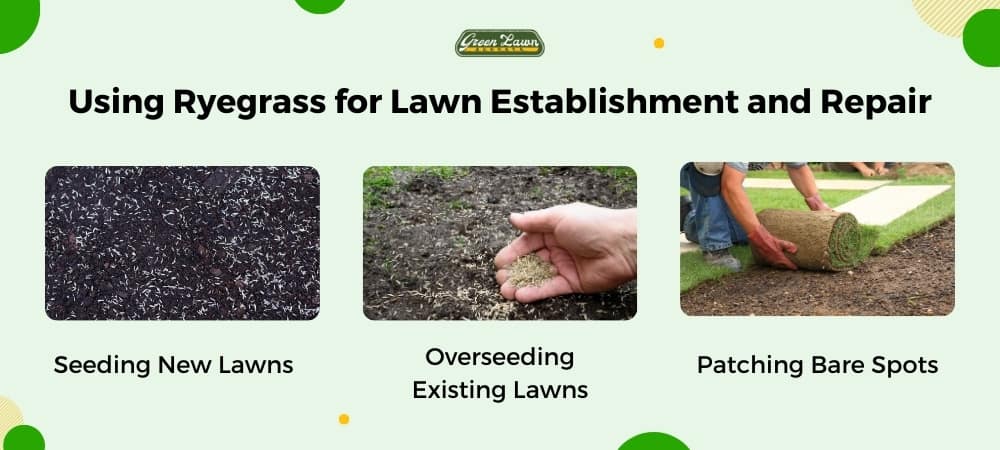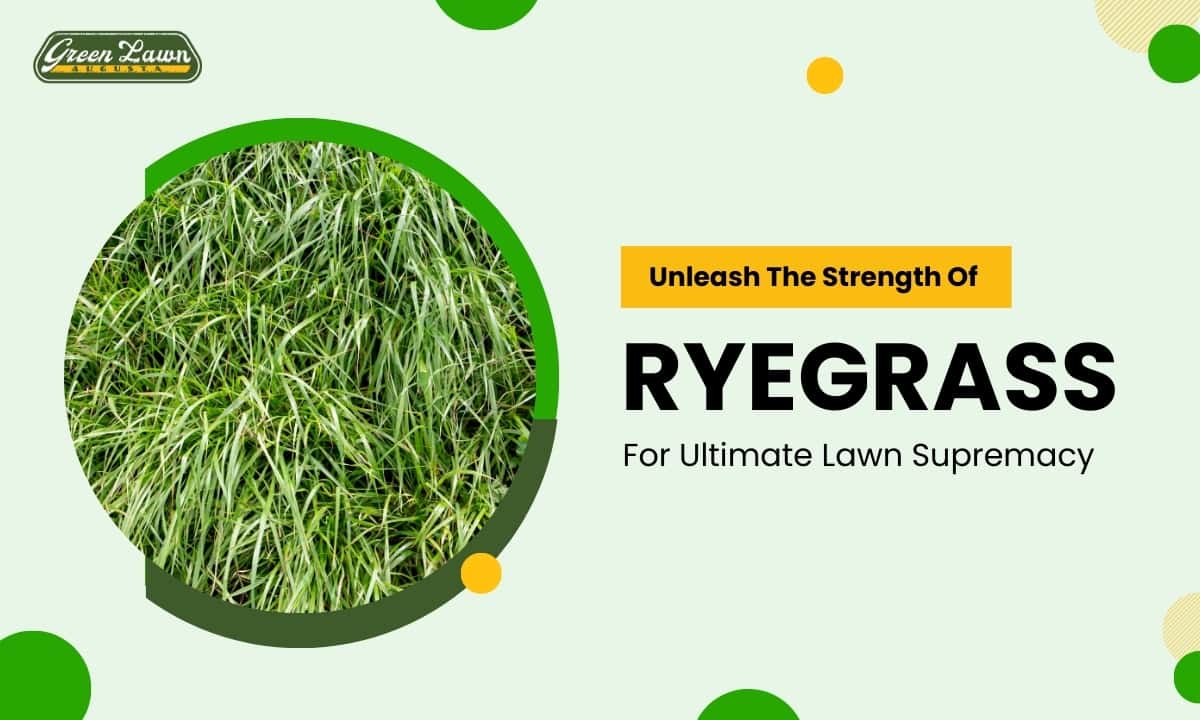Ryegrass can transform your yard from drab to fab quicker than you can say ‘lawn supremacy’! With its colour and ability to grow in various climates, Ryegrass isn’t just sturdy; it’s downright Herculean!
Table of Contents
ToggleKey Takeaways
- Lawn mowing techniques should include cutting grass to the recommended height, keeping mower blades sharp, practising grasscycling, and avoiding over-mowing to allow ryegrass to grow and thrive.
- Adequate fertilization, particularly with nitrogen and phosphorous, is essential for the growth.
- Dethatching is necessary to prevent thatch buildup and maintain a health.
- Proper irrigation strategies, finding the right watering balance, and positioning sprinklers correctly are crucial for maintenance.
What Makes Ryegrass a Powerful Grass

Ryegrass is a powerful for several reasons.
Rapid Germination and Growth
You’ll be stunned by how quickly ryegrass germinates and grows, giving your lawn a lush makeover in no time. Its speed is like the grass version of instant noodles but way healthier for your yard!
- Germination Timing: Ryegrass pops up faster than a jack-in-the-box! In just 7 to 10 days, you’ll see green sprouts breaking through.
- Seed Variety & Hybrids: Not all Ryegrasses are created equal. Some are purebreds, while others are hybrids boasting superior traits. They’re like the superheroes of the grass world!
- Soil Preparation & Climate Considerations: Ryegrass thrives in well-prepared soil and cool climates. It’s your yard dressing for autumn.
Strong Cold Tolerance
Despite the chill in the air, don’t fret; your grass can handle winter’s harsh bite. Ryegrass doesn’t just survive in frigid temperatures; it thrives!
By winterizing ryegrass properly, you’ll prevent snow damage and establish lawn supremacy throughout the year. So, while others are mourning their frozen foliage come springtime, you’ll be basking in your lush green kingdom.
Disease and Insect Resistance
Not only is it a champ in the cold, but it’s also a pro at fending off diseases and pesky insects. Yes, you heard that right! Ryegrass Moonlights is your personal pest management team.
Want to know why? Let’s dive into some resilience analysis. This grassy superhero doesn’t believe in lying down when faced with adversity – oh no! It fights back with its natural insect repellents and disease detection mechanisms, making it a tough cookie for those sneaky bugs and fungal intruders!
Using Ryegrass for Lawn Establishment and Repair

Seeding New Lawns
Soil preparation is key – think of it as rolling out the red carpet for your grass selection.
Optimal planting time isn’t just ‘when you feel like it’. Ryegrass thrives in cooler seasons, so mark your calendar accordingly.
Of course, you’ll need some lawn care tools – a rake isn’t going to cut it here. And remember, seasonal maintenance is crucial unless you fancy turning your yard into a wild prairie!
Overseeding Existing Lawns
Imagine your existing green paradise looking worn and threadbare; it’s time to consider the magic of overseeding. This isn’t just sprinkling fairy dust, my friends! It involves strategic soil preparation, choosing the perfect seed varieties, and mastering seasonal timing.
Mowing techniques also play a crucial role here; mow low before you sow! And don’t forget; your lawn is thirsty for that H2O goodness. The right watering frequency can make or break this operation.
Patching Bare Spots
Don’t let those unsightly bare patches in your beloved green sanctuary get you down – patching them up is a cinch with the right know-how! You’ve got two options to turn this situation around, and both involve our favourite hero – ryegrass.
Option 1: Sodding
Just prepare your soil properly and lay down some fresh ryegrass sod. Different ryegrass varieties can offer different benefits. Choose wisely!
Option 2: Seeding
This one requires patience, grasshopper. But don’t worry, your hard work will pay off! Start with weed control (no one likes an uninvited guest), then move on to ryegrass blending for the ultimate lawn supremacy.
Maintaining a Hardy Ryegrass Lawn

There are several steps you can take to maintain a hardy ryegrass yard.
Proper Mowing Height
Proper mowing height is crucial for maintaining dense ryegrass.
Aim for an ideal height of 1.5 to 2.5 inches. This will give your yard a carpet-like texture and vibrant green colour.
Keeping your mower blades sharp is essential for achieving clean cuts and promoting healthier grass. Dull blades will leave your lawn looking messy as if it woke up on the wrong side of the bed.
Grasscycling is not a race but rather a practice of leaving clippings behind after mowing. This adds valuable nutrients back into your lawn, providing mulching benefits.
Adequate Fertilization
Nitrogen is like your lawn’s personal trainer for growth – pumping up those green blades just like gym rats pump iron.
And don’t forget Phosphorous, the unsung hero of root development – think of it as the deep-down strength training for your grassy gladiators.
Nitrogen for growth
Nitrogen for growth can work wonders for your ryegrass, turning your lawn into the talk of the town. It’s like a shot of espresso for your grass! Let’s break it down:
- Grass Coloration: Nitrogen is the key to greener grass. It gives your lawn that vibrant and lush appearance that everyone desires.
- Nitrogen Deficiency: Without nitrogen, your lawn will be screaming for nutrients. It’s like grass begs you to feed it and provide the necessary nitrogen to thrive.
- Soil Enrichment: It enhances soil fertility, creating a happy and healthy environment for your grass to grow and flourish.
- Fertilizer Types & Nitrogen Cycle: Understanding the different types of fertilizers and the nitrogen cycle is like being a lawn scientist. It allows you to make informed decisions about best-providing nitrogen to your ryegrass.
Phosphorous for root development
Phosphorous is like the secret underground agent for your grass, working stealthily beneath the surface to develop robust root systems.
Beware of phosphorous deficiency, which can leave your ryegrass frail and feeble.
Organic phosphorus helps optimal root absorption but remember to check your soil pH.
Dethatching to Prevent Thatch Buildup
Don’t let thatch buildup ruin your lawn’s potential; dethatching is important in maintaining healthy ryegrass. Thatch decomposition can be slower than your grass’s growth, leading to a spongy layer that chokes out the good stuff.
To win this round of ‘Thatch vs. Mulch: Lawn Edition,’ you’ll need some sturdy thatch removal tools. Here’s how:
- Identify when to dethatch (usually when the layer exceeds half an inch thick).
- Arm yourself with a good dethatching rake or power dethatcher.
- Rake away! Remember, it’s not a beauty contest at this stage.
- Compost the removed thatch for an eco-friendly solution.
Irrigation Strategies
It’s all about timing with watering schedules.
Too much H2O? You’re drowning your ryegrass.
Too little? It’s gasping for moisture like a fish out of water! Find that Goldilocks spot- not too wet, not too dry.
Sprinkler positioning is vital; don’t be someone who waters the sidewalk more than their lawn! And when drought hits, your grass’s response needs to be top-notch – think Rocky Balboa in a boxing match!
Conclusion
Ryegrass is a powerful choice for homeowners seeking durability, color, and quick germination in their lawns. To get the most out of your turf, explore the best way to overseed a lawn in 7 simple steps and keep your lawn healthy year-round with fall lawn care musts. Don’t forget the importance of basic weed control and the best weed killers to protect your investment. If pests are an issue, learn how to identify common lawn pests in Augusta, and for families with pets, review our dog-friendly lawn care tips. Want a different type of turf? See the superb strengths of bentgrass. For tailored treatments that bring it all together, check out Green Lawn Augusta professional Augusta lawn treatment services and get started today.

